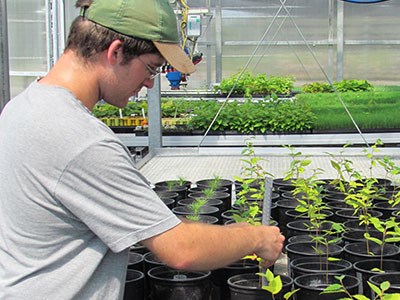An applied research project being undertaken at Collège Boréal could enhance the way regreening is done in Sudbury, while creating opportunities for value-added products for the North’s forestry companies.
This summer, the college started testing the properties of biochar—a fairly new word used to describe charred organic material leftover from the burning process at lumber mills—to see if it can be added to soil to reduce its acidity.
Biochar, a form of charcoal, describes the material left over after burning bark that’s stripped from trees after it enters a mill. Typically, because there is little other market for the bark, it’s burned to generate heat in the production of kiln-dried lumber.
Marc Hébert, a teacher in Boréal’s forestry and natural resources program who’s heading up the project, believes biochar could be used to replace the dolomitic limestone that is typically used in Sudbury’s regreening projects.
“Because I’m a forester and I work in forestry, I was trying to think of, ‘Is there something that could replace limestone?’” Hébert said. “Because limestone, when you produce it, it produces a lot of greenhouse gases and it’s pretty expensive.”
Charcoal has been used in forestry projects for hundreds of years, particularly in Scandinavian countries, Hébert said, but never on an industrial scale. In Ontario, because there are few uses for biochar, it goes into the landfill. Because every other material that goes into the mill comes out as a product, Hébert wanted to see if the bark could also be made into a value-added product.
Biochar has a higher pH level than limestone, and Hébert theorizes that using biochar instead of limestone could help reduce the acidity of the soil, while reducing the cost of limestone and fertilizer used in the reseeding process.
Forestry company EACOM is supplying the biochar produced from jack pine trees at its Nairn Centre mill, but is otherwise taking a background role in the project. The company, which annually purchases 100,000 seedlings from the college, has expressed interest in keeping up to date on the project’s process and could be interested in the future if the experiment shows promise.
In the college greenhouse, Hébert has planted seedlings in 100 pots, 20 of which have soil with a pH of 4.5 (acidic), 10 of which have jack pine seedlings in them and 10 of which have yellow birch seedlings in them.
Another 20 pots have the equivalent of 10 tonnes per hectare of limestone, which is the recipe that the city uses. Other pots use 10, 20 and 30 tonnes of biochar per hectare for comparison.
“We want to see, does it work? Are the results comparable? Does it increase survival? Does it increase the health of the tree by the look of it? Does it increase the growth of the trees, and if so at what level?” Hébert said.
The seedlings will undergo analyses of height growth, pH level, soil, needles, and leaves to see whether they pick up any of the potassium and phosphorus that’s in the biochar, he added. Plant harvesting will take place at the end of October and at that point Hébert will decide whether to move forward with next phase of project.
“If it shows nothing, that’s the end of the project,” Hébert said. “If it shows some positive results, the next step would be to try it in the field.”
There are some challenges with the product. Hébert said biochar floats when applied to the surface of soil, which could be a problem if it ends up in the water. But that’s a challenge that could be addressed later in trials. Right now, he wants to see whether biochar can actually work.
Other research has gone into biochar in the use of land reclamation, Hébert said, but mostly with relation to mine tailings. This is the first time anyone has looked at biochar for use in regreening, particularly in the Sudbury area, Hébert said. As the first applied research project being done by Collège Boréal, the biochar experiment is giving students opportunities to train in analysis, ultimately positioning itself as an expert in this kind of research.
At same time, Hébert sees opportunities down the road for collaboration with other forestry companies, helping to create another value-added product for the industry.
“Eventually, that’s what we’re hoping—that there will be a new product stream for those industries,” he said. www.collegeboreal.ca




